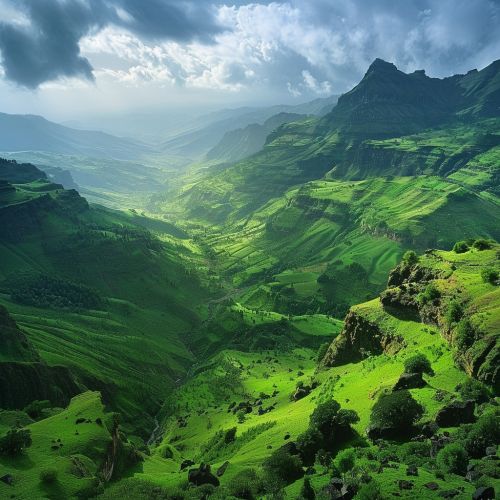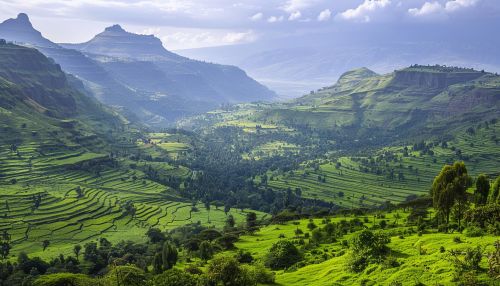Ethiopia
Geography
Ethiopia is a landlocked country situated in the Horn of Africa. It is bordered by Eritrea to the north, Djibouti and Somalia to the east, Kenya to the south, South Sudan to the west, and Sudan to the northwest. The country covers a total area of approximately 1.1 million square kilometers, making it the 27th largest country in the world. Ethiopia's diverse topography includes highlands, plateaus, and lowlands, with elevations ranging from 125 meters below sea level in the Danakil Depression to over 4,500 meters above sea level at Ras Dashen, the highest peak in the Simien Mountains.


Climate
Ethiopia's climate varies significantly due to its diverse topography. The highlands experience a temperate climate with moderate temperatures, while the lowlands are characterized by a hot, arid climate. The country has three main climatic zones: the cool zone (dega) with temperatures ranging from 10 to 16°C, the temperate zone (woina dega) with temperatures between 16 and 30°C, and the hot zone (kolla) where temperatures can exceed 30°C. The rainy season, known as the "kiremt," occurs from June to September, while the dry season, or "bega," lasts from October to February.
History
Ancient and Medieval Periods
Ethiopia has a rich and ancient history, with human habitation dating back to prehistoric times. The region is often referred to as the "cradle of humanity" due to the discovery of early hominid fossils, such as the famous "Lucy" (Australopithecus afarensis) in the Afar Depression. The Kingdom of Aksum, which emerged around the 1st century AD, is one of the most significant ancient civilizations in Ethiopian history. Aksum was a major trading empire, known for its monumental obelisks, the introduction of Christianity in the 4th century, and its script, Ge'ez.
During the medieval period, Ethiopia saw the rise of the Zagwe dynasty, which is renowned for constructing the rock-hewn churches of Lalibela. The Solomonic dynasty followed, claiming descent from the biblical King Solomon and the Queen of Sheba. This period was marked by the consolidation of the Ethiopian Orthodox Church and the expansion of the empire.
Modern History
In the late 19th and early 20th centuries, Ethiopia successfully resisted European colonization, notably defeating the Italian forces at the Battle of Adwa in 1896. This victory preserved Ethiopia's sovereignty and made it a symbol of African resistance against colonialism. Emperor Haile Selassie I, who ruled from 1930 to 1974, played a crucial role in modernizing the country and promoting Pan-Africanism. However, his reign ended with a military coup, leading to the establishment of a socialist state under the Derg regime.
The Derg's rule was marked by political repression, famine, and conflict, culminating in the Ethiopian Civil War. In 1991, the Ethiopian People's Revolutionary Democratic Front (EPRDF) overthrew the Derg, leading to the establishment of the Federal Democratic Republic of Ethiopia.
Culture
Ethiopia's culture is a mosaic of diverse ethnic groups, languages, and traditions. The country is home to over 80 ethnic groups, with the Oromo, Amhara, Somali, and Tigray being the largest. Each group has its own unique customs, languages, and cultural practices.
Language
Amharic is the official language of Ethiopia and is widely spoken across the country. Other major languages include Oromo, Tigrinya, Somali, and Afar. The Ge'ez script, used for writing Amharic and Tigrinya, is one of the oldest alphabets still in use today.
Religion
Ethiopia is a religiously diverse country, with Christianity and Islam being the predominant faiths. The Ethiopian Orthodox Church, one of the oldest Christian denominations in the world, has a significant influence on the country's culture and traditions. Islam is also widely practiced, particularly in the eastern and southeastern regions. Additionally, there are smaller communities of Protestants, Catholics, and adherents of traditional African religions.
Cuisine
Ethiopian cuisine is known for its rich flavors and unique dishes. Injera, a sourdough flatbread made from teff flour, is a staple food and is typically served with a variety of stews and curries, known as "wot." Popular dishes include doro wot (spicy chicken stew), kitfo (minced raw beef), and shiro (chickpea stew). Ethiopian cuisine is often enjoyed communally, with diners sharing from a large plate.
Economy
Ethiopia's economy is one of the fastest-growing in Africa, driven by agriculture, manufacturing, and services. Agriculture remains the backbone of the economy, employing around 70% of the workforce and contributing to about 33% of the GDP. Coffee is Ethiopia's most important export commodity, with the country being the largest producer of coffee in Africa. Other significant agricultural products include teff, maize, sorghum, and livestock.
The manufacturing sector has seen substantial growth in recent years, particularly in textiles, leather, and agro-processing. The government has also invested heavily in infrastructure development, including the construction of industrial parks, roads, and the Grand Ethiopian Renaissance Dam (GERD), which aims to boost hydroelectric power generation.
Politics and Government
Ethiopia is a federal parliamentary republic, with a President serving as the head of state and a Prime Minister as the head of government. The country is divided into nine ethnically based regional states and two chartered cities. The federal government is composed of the House of Peoples' Representatives and the House of Federation.
Political Landscape
Ethiopia's political landscape has undergone significant changes in recent years. The EPRDF, which ruled the country for nearly three decades, was dissolved in 2019 and replaced by the Prosperity Party. Prime Minister Abiy Ahmed, who took office in 2018, has implemented a series of political and economic reforms aimed at promoting democratization and national unity. However, the country continues to face challenges, including ethnic tensions, political unrest, and conflicts in regions such as Tigray.
Demographics
As of 2021, Ethiopia has an estimated population of over 117 million people, making it the second-most populous country in Africa. The population is predominantly rural, with around 80% living in rural areas. Ethiopia has a young population, with a median age of 19.5 years.
Ethnic Groups
Ethiopia is a multi-ethnic society, with over 80 distinct ethnic groups. The largest ethnic groups are the Oromo, Amhara, Somali, and Tigray. Each group has its own language, culture, and traditions, contributing to the country's rich cultural diversity.
Urbanization
Urbanization in Ethiopia has been increasing, with major cities such as Addis Ababa, Dire Dawa, and Mekelle experiencing rapid growth. Addis Ababa, the capital city, is the political, economic, and cultural center of the country, hosting numerous government institutions, businesses, and cultural landmarks.
Education
Education in Ethiopia has made significant strides in recent decades, with increased access to primary and secondary education. The government has implemented various policies to improve the quality of education and increase enrollment rates. However, challenges remain, including disparities in access to education between urban and rural areas, and issues related to educational infrastructure and resources.
Higher Education
Ethiopia has a growing higher education sector, with numerous universities and colleges offering a wide range of academic programs. The University of Addis Ababa, established in 1950, is the oldest and most prestigious university in the country. Other notable institutions include Jimma University, Mekelle University, and Bahir Dar University.
Health
Ethiopia has made significant progress in improving health outcomes, with increased access to healthcare services and reductions in child and maternal mortality rates. The government has implemented various health programs, including the Health Extension Program, which aims to provide primary healthcare services to rural communities.
Healthcare System
The healthcare system in Ethiopia is a mix of public and private providers, with the government playing a significant role in the provision of healthcare services. Despite improvements, challenges remain, including limited access to healthcare in rural areas, shortages of healthcare professionals, and inadequate healthcare infrastructure.
Transportation
Ethiopia's transportation infrastructure has seen significant development in recent years, with investments in road, rail, and air transport. The country has an extensive road network, with major highways connecting key cities and regions. The Addis Ababa-Djibouti Railway, completed in 2016, is a major rail link that facilitates trade and transportation between Ethiopia and Djibouti.
Air Transport
Ethiopian Airlines, the national carrier, is one of the largest and most successful airlines in Africa. The airline operates numerous domestic and international flights, connecting Ethiopia to destinations across the globe. Bole International Airport in Addis Ababa serves as the main hub for Ethiopian Airlines and is one of the busiest airports in Africa.
See Also
- Aksumite Empire
- Ethiopian Orthodox Church
- Haile Selassie
- Oromo People
- Addis Ababa
- Ethiopian Airlines
